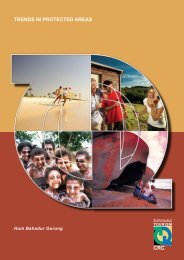icolls - Sustainable Tourism CRC
icolls - Sustainable Tourism CRC
icolls - Sustainable Tourism CRC
You also want an ePaper? Increase the reach of your titles
YUMPU automatically turns print PDFs into web optimized ePapers that Google loves.
ECOLOGY, THREATS AND MANAGEMENT OPTIONS FOR SMALL ESTUARIES AND ICOLLS<br />
opportunities for gathering more information of patterns of movements for species like A. marianus where<br />
existing data is scant.<br />
Whilst we did not sample nearshore environments in the current study, we propose that fish emigrating from<br />
Tallows Creek will maintain these enriched δ 15 N signatures for a reasonable period of time (at least weeks),<br />
particularly for species that undertake non-feeding movements in response to environmental cues (e.g. Mugil<br />
cephalus – Pusey, Kennard & Arthington 2004). These enriched isotope signatures in emigrants might be useful<br />
in determining patterns of movement into and out of neighbouring offshore and estuarine habitats (Hansson et al.<br />
1997; Herzka 2005). Given that many of the species that inhabit intermittently open estuaries are of marked<br />
commercial and recreational value (Griffiths 1999; Griffiths 2001b), the use of these stable isotope markers to<br />
improve our understanding of recruitment and movement patterns deserves further attention.<br />
We have shown in this study that in small intermittently open estuaries, sewage effluent can enrich all<br />
components of the food web. The enriched δ 15 N signatures of resident biota can be used to assess patterns of<br />
movement by mobile taxa like fish (Hansson et al. 1997; Herzka 2005). We propose that heavily enriched<br />
systems like Tallows Creek can provide excellent opportunities for assessing patterns of fish recruitment and<br />
ecosystem processes (like nutrient cycling), without the inherent costs and impacts associated with adding 15 Ntracers<br />
and nutrients to an otherwise undisturbed site (Peterson 1999; Bedard-Haughn, van Groenigen & van<br />
Kessel 2003). Studies of this nature are likely to be particularly relevant to coastal resource and fisheries<br />
managers, as the findings will enable the evaluation of the role that intermittently open estuaries play in<br />
sustaining the viability of commercially and recreationally valuable fish populations (Griffiths 1999; Watts &<br />
Johnson 2004).<br />
35











